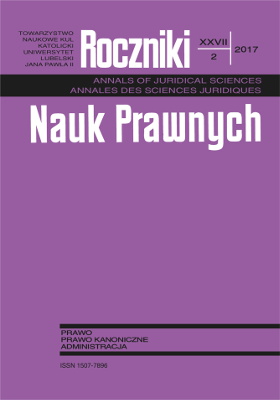Ewolucja diakonatu kobiet w ustawodawstwie synodów galijskich u schyłku chrześcijańskiej starożytności
The Evolution of the Diaconate of Women in Gallic Synods’ Legislation in Late Christian Antiquity
Author(s): Marcin BiderSubject(s): Christian Theology and Religion, Law, Constitution, Jurisprudence, History of Church(es), Theology and Religion, Canon Law / Church Law
Published by: Towarzystwo Naukowe KUL & Katolicki Uniwersytet Lubelski Jana Pawła II
Keywords: deaconesses; ordination; widows; consecration of virgins; monasticism; st. Radegund
Summary/Abstract: The reconstruction of the canonical structure of the female diaconate institution in Gaul from the 4th to the 6th century, due to scarse preserved legal sources, encounters serious difficulties. The laws of the six Gauls's synods have been preserved to our times, which studied the widely understood issues of deaconesses. The synodal agenda also included questions related to determining the canonical status of widows and consecrated virgins, from which candidates for the Gaul’s deaconesses were recruited. The process of crystallization of the legal norms, regulating the female diaconate, came about in the context of the ongoing priscillian disputes and the emerging of the monastic movement. Despite the subsequent synods’ reiteration of their opposition to the phenomenon of ordination of deaconesses, they were certainly still present in Gaul in the 6th century, as evidenced by the preserved literary and epigraphic testimonies. As a result of the evolution of the term „diaconal” in the 6th century, one more meaning was added, namely, the wife of a deacon.
Journal: Roczniki Nauk Prawnych
- Issue Year: 27/2017
- Issue No: 2
- Page Range: 97-128
- Page Count: 32
- Language: Polish

